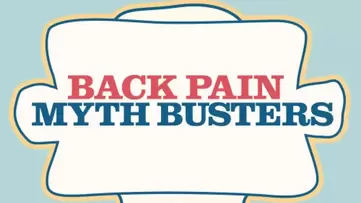|
Chronic low back pain is one of the leading causes of disability across the world, not just in Australia. Some people with low back pain are able to live a relatively normal lifestyle which is not influenced to a great degree, however there are many others that have disabling back pain. Disabling back pain can stop sufferers from working, playing with their kids, going on social outings, playing sport, exercising and in severe cases stopping them from being able to perform their daily living tasks. There are a lot of misconceptions or myths around back pain that have become widely thought and used in the management of back pain. These myths and misconceptions may actually hinder your management and progression out of back pain. In 2019 a group of researchers and Physiotherapists found that they were seeing clients with already strong beliefs around back pain that were not factually correct. They continuously found these common misconceptions and wondered why there was such a gap between clinical practice or common knowledge and what the research says about back pain. Therefore they set out to write 10 facts about back pain backed by research to address the most common misconceptions. Underneath I have outlined the 10 facts about back pain they have discussed in the scientific paper they have published. Fact number 1: Persistent back pain can be scary but rarely dangerous Back pain, if bad enough can disrupt your whole life, it can stop you from working, socialising and exercising therefore has a more profound impact on your life than just physical pain. That’s scary stuff! But the good thing is that even though it is scary and maybe very painful it is rarely dangerous or life threatening. The statistics are only 1-2% of back pain is of a serious pathology that requires immediate attention from the GP or specialist. So yes it does happen but it is very very rare. Fact number 2: Getting older is not a cause of back pain Widely common belief that getting older is a cause of back pain and that if you have back pain, it will only get worse as you age. This is not backed by research and you can certainly recover and manage back pain at any age of life. Fact number 3: Persistent back pain is rarely associated with serious tissue damage The large amount of research around pain sciences now has helped us understand persistent pain. The human body is strong, and when we do have an injury, tissue healing will occur and generally occur within the first 3 months of the injury. If pain persists past this time it may mean there are other contributing influences such as poor sleep, nutrition, overall health and stress, anxiety or worry. Fact number 4: Scans rarely show the cause of damage Scans are an outstanding bit of technology in which we would be nowhere near where we are today without. Unfortunately scans can tell us lots of scary sounding things but can't actually tell what is the cause of pain or how much pain should be felt. Scans also don't tell us that people without pain can have these scary sounding things as well. Scans are great and necessary but for a smaller number of people. Fact number 5: Pain with exercise and movement does not mean you are causing harm This one is a simple one for me, movement and exercise is one of the best ways to manage and treat low back pain. When people have persistent pain, over time their body will become sensitive to movement and therefore exercise, this however does not mean you are causing harm, it just reflects how sensitive you are. Exercise is again one of the best ways to improve this sensitivity and should be done with a gradual approach. Finding something you enjoy and will consistently do is the key. Fact number 6: Back pain is not caused by poor posture The way you sit at your desk, bend to pick something up or stand around has not been shown to cause back pain. Although certain postures may be painful at times, this does not mean they are the cause of pain. The key to posture is variety, not staying in one position too long. Below I am sitting in all different types of posture which are okay to do but not for too long! Fact number 7: Back pain is not caused by a weak core Hands up if you have heard you need to strengthen your core because you have back pain? This is widely thought and recommended. Yes a strong core is important for human movement and having strong core muscles when we need them is really important. However for many people with low back pain the core muscles are often overactive and cause a tight tense feeling. This is not helpful. Learning to have your core muscles engage when you need them and relax when you don't can be really helpful. Fact number 8: Backs do not wear out with every day loading and bending Everyday loading of the back through bending, twisting and lifting is actually really good for the back and makes you stronger and healthier, just like lifting weights does. However, also like lifting weights, it is important you practice regularly, start and progress slowly and don’t do much more than your current capacity. Fact number 9: Pain flare ups do not mean you are damaging yourself
Flaring up pain can be a scary time however this generally does not mean more damage or a re-injury. Preventing factors such as your overall health (sleep, stress, mood, thoughts and emotions) Staying calm, positive and continuing to move as much as tolerable during a pain flare up is the key to successfully managing back pain flare ups. Fact number 10: Injections, surgery and strong drugs are usually not a cure Some commonly used treatment methods such as injections, surgery and strong drugs can be beneficial for short term gain however they aren’t that effective long term and can actually come with some harmful side effects. Of course everyone is an individual and everyone's back pain is different however these 10 facts are a great start in understanding back pain and getting you moving. Online there is a great resource that can get you started, you can hear from people with lived experience of back pain and how they have managed and overcome this pain. Link: http://www.pain-ed.com/public/patient-stories-2 As always, if you do have any questions regarding this blog please don't hesitate to ask. Izaac Boylan Accredited Exercise Physiologist
0 Comments
|
AuthorSLisa Parkinson Archives
July 2024
Categories
All
|




 RSS Feed
RSS Feed